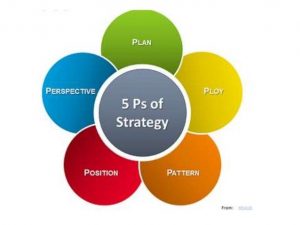Henry Mintzberg’s 5 Ps for strategy
Henry Mintzberg is an internationally acclaimed academician and author on business and management. He is currently the Cleghorn Professor of Management Studies in Montreal, Canada where he is been teaching since 1968. A strategy is defined as a method or a plan chosen to bring about a desired output. Henry Mintzberg suggests there are five factors to be viewed in term of strategy. This perspective of Mintzberg is famously known as ‘5Ps for Strategy’. Strategy can mean a plan, a ploy, a pattern, a position or a perspective.
Strategy as Plan:
Mintzberg notes in this definition that a strategy is an envisioned, or deliberately followed path of action. The strategy is made in advance of its implementation and is followed up by actual implementation and development. Organizations follow a scientific plan or path after designing a strategy.
For example, in its strategic Alliance with Etihad Airways, Jet Airways enhanced its synergies with partners by expanding its codeshare partnership, which has a 24% stake in Jet Airways. The overall codeshare traffic witnessed growth of 28% from 416,816 passengers carried from the third quarter of 14-15 to 534,104 passengers in third quarter of 15-16. The traffic grew by almost 86%. Jet Airways, together with Etihad Airways, now has the largest market share in Indian international traffic. With this strategic alliance, Jet Airways will get more benefits on costs as the financial situation improves and will be able to negotiate better terms on contracts along with Etihad Airways group of airlines.
Strategy as Ploy:
A ploy is a sly plan or action designed to turn a situation to one’s own advantage. A ‘ploy’ is usually a move in a competition or a game, one that is taken to beat the competitor. A ploy takes advantage of opportunities that arise. Business organizations design ploys to undertake or to dissuade competitors from entering the market. But sometimes new entrants come with a ploy by building new facilities with plenty capacity, or lowering prices.
Baba Ramdev’s Patanjali Ayurveda has assessed the scope of the FMCG market in India, it entered the segment by offering products at cheaper prices and using the franchise outlets to gain the reach in far flung markets. Currently, over 4,000 outlets operate and sell Patanjali products. Going by the popularity of the products, Reliance Retail store, Reliance Fresh entered into agreement with Patanjali and have offered exclusive kiosks for selling it products. And now, the company aims to expand sales to online and bring it on e-commerce majors like Amazon.
Patanjali has grown into a big corporation; it now competes with HUL, P&G, Emami Ltd., Marico Industries Ltd., Pepsi Co. and other such global FMCG giants. The most important factor for the high profits is minimum marketing expenses. This organization has a strong brand ambassador in Baba Ramdev who enjoys big following. Their brand ambassador echoes brand’s authenticity and relevance and that’s enough to draw people to adopt the products. The products entered the scene as ‘healthy’ substitutes and are offered at cheaper prices. The brand is entirely pushed into market by baba’s popularity.
Strategy as Pattern:
The way strategies are planned bring out strategic consequences. While strategies are planned, the outcomes cannot be. The results can be positive or negative. Organizations cannot always be accurate in their plans because the business atmosphere is full of complexities. In some cases it may be possible to look back at what has happened, and describe a company’s strategy in terms of a pattern that emerged.
The merger of Air India and Indian Airlines brought together two unequal entities and created a mayhem; a bloated headcount of 30517 employees, failed leadership, disintegrated human resource practices, poor operations, leaky financials, the problems are too many to list. With Air India grappling with financial crisis, the Supreme Court rapped the government for giving “profitable routes” to private carriers and asked it to plan a turnaround in the national carrier saying it will face extinction if things continued like this. The merger caused more chaos than before. One lesson the government needs to learn from the Air India-Indian Airlines merger fiasco is that combining two sick entities ends up making them sicker than before. The ministry of aviation failed miserably due to lack of leadership.
Strategy as Position:
Strategies are planned for locating or fit a business within its environment, and deciding on what position to adopt; e.g. market position, brand position, product portfolio etc. A position may be a niche, providing low cost or distinctive products, or by exploiting competences to prevent others entering in the market.
Packaged consumer goods firm Hindustan Unilever Ltd (HUL) recently acquired Kerala-based hair oil brand Indulekha for Rs.330 crore for marking a comeback to the segment which it had exited in 2006 by selling its coconut oil brand ‘Nihar’ to Marico. HUL signed the agreement with Kannur-based Mosons Extractions Pvt. Ltd to acquire Indulekha hair oil brand. The acquisition of Indulekha adds a premium brand to HUL’s portfolio. HUL aims at making their presence felt in the hair care category. Indulekha enjoys strong loyalty among consumers. HUL sees an opportunity in leveraging its ‘naturals’ and therapeutic positioning. This move is in line with HUL’s strategy to take on competition in the hair care segment.
Strategy as Perspective:
Understanding the significance of a business’s strategic perspective invariably encourages business leaders to create a stronger strategic perspective in hopes of making better decisions. Strategy can be defined in terms of a firm’s corporate personality and culture a company has adopted over time. Strategy is the way a company views itself in the world, through the eyes of its stakeholders – its management and employees. This can refer to organization culture.
ITC – the Indian multi business conglomerate has transformed itself from a leading cigarette manufacturer to an umbrella group that offers a diversified product mix to enhance its brand image and reduce dependency on tobacco related products. It has forayed into various segments such as the hospitality service industry, FMCG, lifestyle etc. It has become a major player in the hotels segment. Its position in the FMCG business is also on a growth curve; especially its confectionery and biscuits which are slated to achieve the top ranks among its peers. It has made heavy investments to strengthen its information technology segment and to compete with the big players like Infosys and Wipro. Although the ITC group is marketing its image as an ideal corporate citizen and a company that takes its social responsibility seriously, it still earns 80% of revenues from selling cigarettes and other tobacco related products. Its corporate strategy is aimed at creating multiple avenues of growth based on its core competencies. In line with this strategy, ITC’s diverse strengths are leveraged across three product groups – Lifestyle Retailing, Greeting Cards & Gifts and Branded Packaged Foods. The company aimed at generating 40 percent of its total revenues from such diversified businesses. The corporation is pro employee and maintains a healthy employee culture.
Conclusion: Mintzberg’s 5Ps are not mutually exclusive. However, they can and often do complement each other. Each P’s definition adds important elements to our understanding of strategy. The 5 Ps help us to address fundamental questions about organization culture in general. As plan, strategies deal with how leaders try to establish direction for organizations, to set them on determined courses of action. As ploy, strategy takes dive into the realm of direct competition, where competitor’s weaknesses and other maneuvers are employed to gain advantage. As pattern, strategy focuses on action. As position, strategy encourages us to look at organization’s position in context, specifically in their competitive environments. And finally as perspective, strategy raises exciting questions about intention and behavior in a collective context.


















































